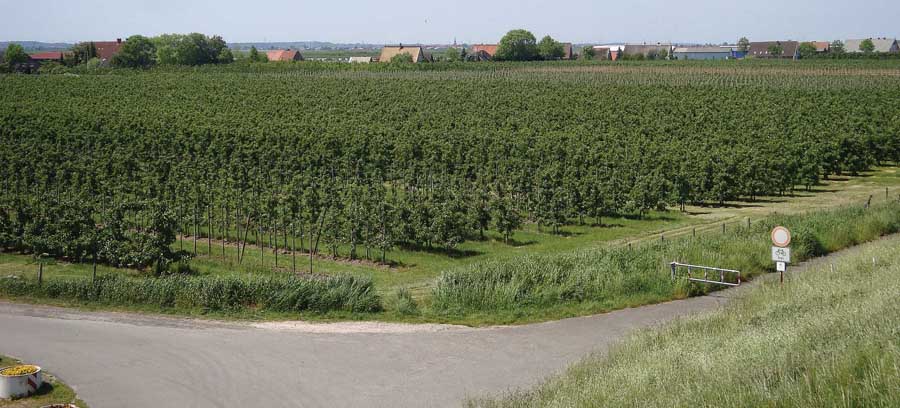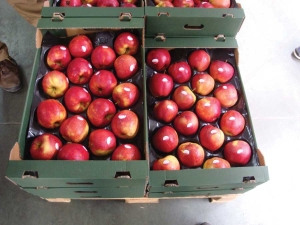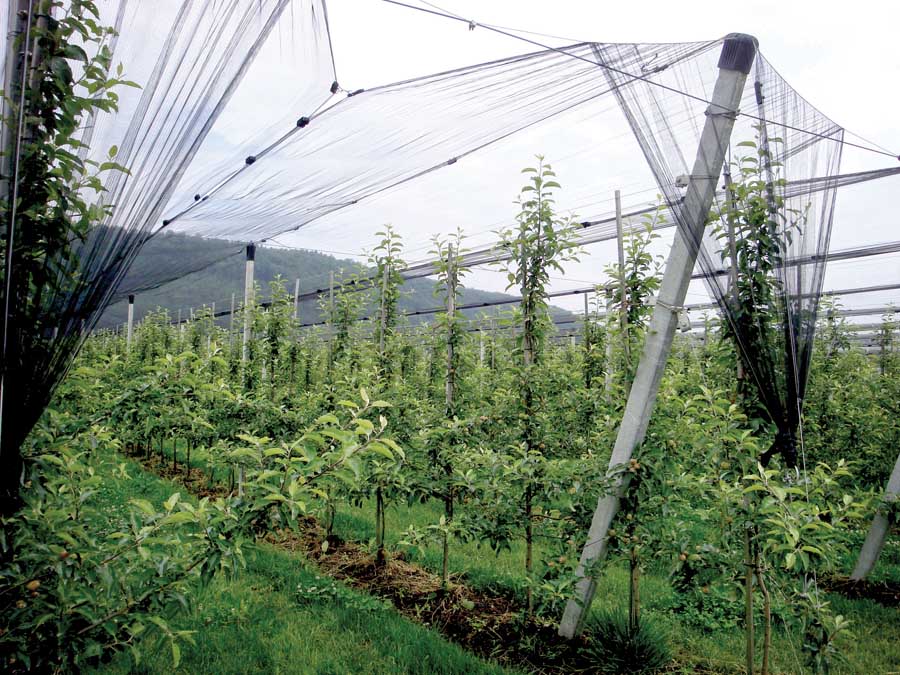
Germany’s Altes Land fruit growing region has thousands of acres of modern, high-density orchards at an elevation of just three feet. (Photos courtesy David Granatstein and Harold Ostenson)

David Granatstein (center) and Harold Ostenson (right) visit with Peter Rolker of Rolker Fruit, an organic fruit producer in the Altes Land area of Germany.
As Washington State produces larger and larger volumes of both conventional and organic apples, producers are likely to look to global markets to take additional supplies.
David Granatstein, Washington State University sustainable agriculture specialist, and organic consultant Harold Ostenson recently attended a conference on integrated and organic horticulture in France.
As part of the trip, they visited apple-growing regions in Poland, Germany, and Switzerland, as well as France, where they learned more about Washington’s potential competitors in Europe and their ability to compete globally in the conventional and organic apple markets.
Granatstein and Ostenson discussed their findings in an interview with Good Fruit Grower.
Washington’s certified organic fresh apple shipments—estimated at almost 10 million boxes for the 2015-16 season, could double by 2020, based on estimates of new orchard land becoming certified.
Interest in organic has been heightened by the significant premiums growers have received.
For example, the average f.o.b. price for organic Gala for the 2014-15 season was $40 a box, exactly double the conventional price.

Germany (upper left): The typical packing plant in Germany has solar panels on the roof, which supply most of the facility’s power. Poland (upper right): Many of Poland’s packing houses have been built in the past decade with subsidies from the European Union and feature modern robotic equipment. France (lower left): French growers are using low-input and ecological growing methods, a strategy that has led to low yields. The grower at this orchard is providing nesting boxes for red mason bees (Osmia rufa) to enhance pollination. Switzerland (lower right): The packaging of these Idared apples, on sale at a Swiss grocery store, provides consumers with a lot of information, including: variety name, taste group (mild, sweet), region of origin, name of the organic certifier, date of packing (June 12), weight, and price (the equivalent of U.S.$3 a pound). (Jared Johnson/Good Fruit Grower)
Poland
Poland is the largest apple producing country in Europe. This year’s total crop is estimated at 3.75 million metric tons (equivalent to 206 million bushels), about the same as last year. That’s 30 percent of the total crop in the European Union.
Italy is the second-largest producer with 2.3 million tons forecast this season (about the same as Washington), and France is third with 1.6 million tons.
Granatstein and Ostenson visited the Research Institute of Horticulture at Skierniewice, Poland, which has 125 doctoral scientists working on fruit and vegetable research and has 1,000 acres of experimental ground.
They also visited Poland’s main apple growing district around Gródek, which has 100,000 acres of apples—about the same as Washington State. Historically, when the land was allocated to families, it was divided into long strips, perhaps a kilometer long and tens of meters wide, in an attempt to avoid some people receiving better farmland than others. However, this configuration complicates the spray program, particularly for organic.

Most Polish apple packing facilities are equipped with dynamic controlled atmosphere storage, which allows long-term storage of fruit without treatment with chemicals such as DPA (diphenylamine) or 1-MCP (1-methylcyclopropene) to preserve fruit quality. These 2014-crop Jonagold apples were being packed in early June this year. (Photos courtesy David Granatstein and Harold Ostenson)
Poland has 312 apple packing plants, most of them built since 2004 when the country became a member of the European Union. The EU offers subsidies for construction of packing houses and favors cooperatives, so many small growers have gone into business together. Poland also receives preferential treatment because of its status as an emerging economy.
Apples are presized and put into storage rooms that typically have a capacity of 480 bins and are equipped with dynamic controlled atmosphere (DCA). Apples are packed on demand. Packers take orders in the morning, pack the fruit in the afternoon, and truck it to a distribution center by evening. Trucks can travel freely within mainland Europe.
Ostenson learned that Poland exported half of its apple crop last season. Its main varieties are Idared, Gala, Jonagold, Golden Delicious, Pinova, Topaz, and some local varieties. Russia was a big market before it imposed an embargo in response to U.S. and E.U. sanctions over Ukraine. Fruit is still shipped into former Soviet states, including Belarus.
Because of the difficulties of exporting to Russia, Poland is now eyeing the same markets as Washington—in Asia, Indonesia, and the Middle East for example—and is 4,000 miles closer to India.
Most of the packing companies have their own sales desks, but they are beginning to merge so that they can supply sufficient quantities to fill ships headed for export markets. For example, a ship traveling from Poland to Indonesia would get there in half the time if it didn’t have to stop to pick up other freight along the way.
“They’re the sleeping gorilla that’s wakening up,” Ostenson warned. “I think they’re going to be a major exporter in the world. They’re going to have some advantages from their location, and they’re a non-EU currency country so currently their wages are a fifth of other countries.”
Although Poland has about 120,000 acres of apples under organic management, encouraged by EU subsidies for organic conversion, production is very limited. The country has skilled horticulturists and a similar climate to other parts of Western Europe, so organic production should be feasible, but many of the orchards are unmanaged and growers lack organic materials, Granatstein reported.
While the EU sets a minimum organic standard, each country in Europe has its own process to certify organic materials, and only four products useful in organic apple production have been approved in Poland so far.
Also, there’s little demand for organic fruit within Poland. In other European markets, Polish organic apples would have to compete with those from Italy, which produces about 3.5 million boxes of organic apples annually.
Germany
From Poland, Granatstein and Ostenson went to Germany to visit the Altes Land apple-growing region established on reclaimed marshland on the Elba River estuary, near the port of Hamburg. The area has 35,000 acres of apples, of which about 10 percent are organic. Germany as a whole has an estimated 12,000 acres of organic apples.
The average orchard in Altes Land is about 50 to 100 acres. All the packing plants that Granatstein and Ostenson visited had solar panels covering their roofs and were self-sufficient in power despite the often gloomy climate. Europe offers subsidies for using renewable energy sources.
Apple scab is a major problem but researchers have developed programs and protocols that work well enough to produce high-quality fruit. Ostenson said the quality of their organic fruit was comparable to Washington’s and sold for about double the conventional market price.
France
Ostenson and Granatstein visited an apple-growing region in the southern Rhône Valley in France where growers were switching to low-input and ecological growing methods, a strategy that is negatively impacting production.
Yields were only about 25 bins per acre—half what they could have been. Hedgerows that had been planted to attract beneficial insects had reduced fruit damage by pests, but not to acceptable levels.
Growers were still applying 30 to 35 sprays per season in organic orchards.
“It’s a different world,” Granatstein commented. “It’s warm and humid. It’s like disease heaven.”
Although the French have been investing in research to try to make organic fruit production more feasible, there did not appear to be much land being converted to organic because of the challenges they’re facing.
Switzerland

An organic orchard near Frick in Switzerland is protected by a hail cover.(Photos courtesy David Granatstein and Harold Ostenson)
Though Switzerland has a very small apple industry producing less than 8 million boxes, it makes a significant investment in research and extension. Ostenson and Granatstein visited the Swiss Research Institute of Organic Agriculture at Frick, which employs 100 people who focus exclusively on organic production.
Switzerland tries to produce as much of its own fruit as possible and places tariffs on imports while domestic supplies are available. The two major grocery chains, Coop and Migros, are very supportive of organic.
Granatstein said he had expected to see scab-resistant cultivars as the cornerstone of organic apple production in Europe, because of the humid climate, but that did not seem to be the case. There are reports of resistance breaking down and other flaws that stopped their expansion.
Organic still looks like a good bet for Washington growers who are looking to diversify, Granatstein said, though the expected increase in organic production in Washington seems like a big increase for the market to digest. Most production so far has gone to the domestic market and Canada. Of last season’s crop of 9.5 million boxes of organic apples, only 604,000 were exported, and 84 percent of those went to Canada.
Although large global apple production increases will put pressure on prices overall, Ostenson does not think this will be the case with organic apples because demand exceeds supply.
Last season, Washington produced 30 percent more organic apples than in the previous year but sold out in the same time frame. He expects that Washington’s increasing organic apple production levels will be absorbed by an expansion to year-round supplies combined with increasing exports.
Ostenson concludes that Washington will remain king of organic production for the foreseeable future because of its ability to produce high yields of high-quality fruit. •






Leave A Comment